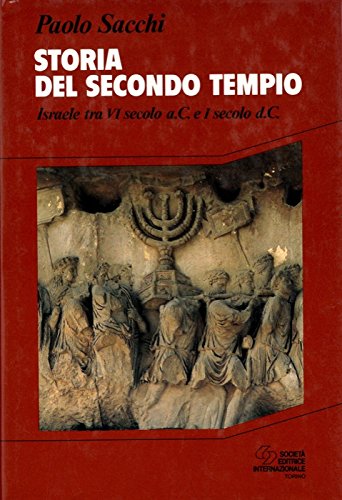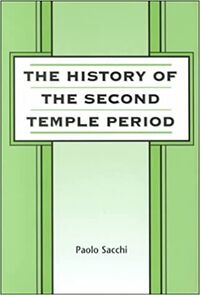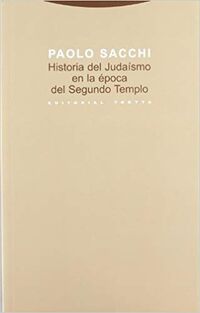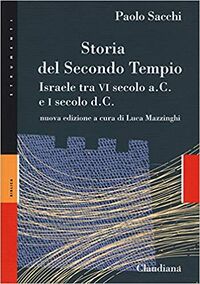File:1994 * Sacchi.jpg
1994_*_Sacchi.jpg (342 × 500 pixels, file size: 46 KB, MIME type: image/jpeg)
{it} Paolo Sacchi, Storia del Secondo Tempio. Israele tra VI secolo a.C. e I secolo d.C. (Turin, Italy: SEI, 1994).
Editions
- Storia del Secondo Tempio, 2nd ed. (2019 @1994 Sacchi / Mazzinghi), book, ed. Luca Mazzinghi (Turin, Italy: Claudiana, 2019).
Translations
- English ed. (2000) : The History of the Second Temple Period, tr. William Short (Sheffield [England]: Sheffield Academic Press, 2000).
- Spanish ed. (2000) : Historia del judaísmo en la época del Segundo Templo, tr. Carlos Castillo Mattasoglio and Adela Sánchez Rojas, ed. Antonio Piñero Sáenz (Madrid, Spain: Trotta, 2004). Colección Estructuras y Procesos: Serie Religión; ISBN 84-8164-686-5.
Abstract
"Per l'Israele antico, il periodo compreso tra VI secolo a.C. e I d.C. - tra la distruzione del primo Tempio di Gerusalemme da parte di Nabucodonosor e quella del secondo, ricostruito, da parte di Tito - fu cruciale: la Bibbia assunse la forma che conosciamo e, nel giudaismo, vennero sviluppandosi rabbinismo e cristianesimo. A partire dagli scritti canonici, dagli apocrifi e dai testi qumranici, Paolo Sacchi ne propone una storia, a impianto soprattutto tematico, in cui la narrazione storico-politica si intreccia alle dimensioni religioso-culturali di volta in volta caratteristiche di un'epoca e gravide di conseguenze per le successive."--Publisher description.
"One of the first major modern studies to explore the second temple period in its entirety, Sacchi’s history (actually beginning from the death of Josiah in 609 BCE and the events leading up to the exile) sets out to place pre-Christian Jewish concepts in the proper context in order to better understand the earliest positions of Christianity. The book is divided into two major sections – the first is Sacchi’s chronological history of the events of the period; the second is his intellectual history based around theme rather than chronology. Sacchi’s fondness for intellectual history is seen in the first section as well, where he often will follow his strict chronology of events with a discussion of the cultural/political ideas which shaped or were shaped by these events, viewing the history of the period through the lens of socio-political struggles for positions of power and authority within the Jewish community. The second section dealing with the themes of “Middle Judaism,” borrowing the term from Gabriele Boccaccini, Sacchi here focuses on the major ideological issues of the post-Zadokite period (200/175 BCE – 70 CE), stressing those movements and those issues which were more relevant to the formation of early Christian thought, issues such as the theodicy, soteriology, and messianism. In making the move from a chronological to a thematic approach Sacchi acknowledges the difficulty in dating most of these texts with any degree of certainty and therefore the difficulty in attaching ideological themes to known historical events. This thematic approach fits well with Sacchi’s goal of situating early Christian thought in a milieu dominated by new and unique concepts developed to deal with common theological problems. A major strength of Sacchi’s approach is in his treatment of each text in its own terms, completely removed from standard theological and modern academic corpora." – Jason Zurawski, University of Michigan
"This book represents the fruit of a long process of study and reflection, a powerful but subtle synthesis, by one of the most eminent scholars of Second-Temple Judaism. Far from a conventional narrative history, it is organized around themes and seeks to uncover the essence of Hebraic/Jewish religious thinking while confronting the phenomenon of its division into several 'parties' and traditions. Drawing also on recent studies of Christianity as a 'Judaism', Sacchi provides a stimulating perspective on the nature of ancient Oriental and Occidental thought and the intellectual and spiritual heritage of European civilization."--Publisher description (English ed.).
"To present, this is the most complete scholarly study on Second Temple Judaism published in Spanish language, and thus a must for all Spanish readers interested in the field. Although translated from the Italian, the Spanish version follows partly the English edition published in 2000 (The History of the Second Temple Period (2000 Sacchi), book (English ed.)), since the Preface to the latter (pages 9-22) is appended as an Epilogue to the former (pages 527-43), which includes, as its English counterpart, a supplementary bibliography (the Italian edition was published in 1994) covering the years 1993-2000 (pages 575-75). Quotations from the Old Testament Pseudepigrapha and the Qumran Scrolls are given after the Spanish editions of both corpora: Apócrifos del Antiguo Testamento (1984-2009 Díez Macho/Piñero Sáenz), edited volume, and Textos de Qumrán (1992 García Martínez), book, respectively."--Carlos A. Segovia, Camilo José Cela University (Spanish ed.)
Contents
Introduction
Part I: The Age of Exile
- 1 – The Events
- 2 – The Jewish Culture of the Sixth Century BCE
Part II: The Zadokite Period
- 3 – Early Zadokitism (c. 520-400 BCE)
- 4 – Nehemiah
- 5 – The Samaritans
- 6 – Late Zadokitism (c. 400-200 BCE)
Part III: Palestine from the Advent of Seleucid Domination to the Destruction of the Second Temple
- 7 – Palestine Under the Seleucids: The Maccabees
- 8 – The Hasmonaeans
- 9 – Judaea at the Time of Jesus of Nazareth
Part IV: The Themes of Middle Judaism
- 10 – Introduction to the Problems
- 11 – The Problem of Knowledge
- 12 – Predeterminism and the Problem of Evil
- 13 – Salvation
- 14 – Messiansim
- 15 – The Righteous
- 16 – Life Beyond Death: The Immortal Soul and the Resurrection of the Body
- 17 – The Sacred and the Profane, The Impure and the Pure
- 18 – The Two Calendars
- 19 – Jesus in His Time
External Links
File history
Click on a date/time to view the file as it appeared at that time.
| Date/Time | Thumbnail | Dimensions | User | Comment | |
|---|---|---|---|---|---|
| current | 13:25, 20 January 2022 |  | 342 × 500 (46 KB) | Gabriele Boccaccini (talk | contribs) |
You cannot overwrite this file.
File usage
The following 2 pages use this file:
- File:1994a Sacchi.jpg (file redirect)
- File:2000-T * Sacchi.jpg




